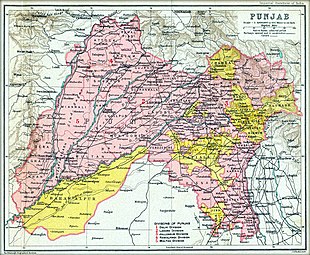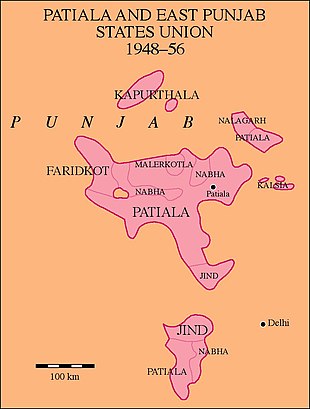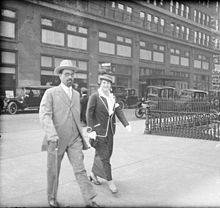Kapurthala (State)
| Kapurthala | |||||
| 1772-1948 | |||||
|
|||||
| Capital | Kapurthala | ||||
| Form of government | Princely state (13 shot salute) | ||||
| surface | 1551 km² | ||||
| population | 314,300 (1901) | ||||
| founding | 1772 | ||||
| resolution | August 20, 1948 | ||||
| State religion: Sikhism. Dynasty: Ahluwalia |
|||||
| Kapurthala (center right) in Punjab, 1909 | |||||
| The states of the PEPSU | |||||
| The Sainik School in Kapurthala, the former Jagatjit Palace, built between 1900 and 1908 | |||||
Kapurthala was one of the Sikh - princely states in the " Punjab States Agency " of British India . The capital and residence city was the city of Kapurthala ( 31 ° 23 ′ N , 75 ° 23 ′ E ) east of Amritsar .
history
The principality was in 1772 by Jassa Singh, the leader of the Ahluwalia - Clans ( Misl ) and one of the leaders ( Sardar or Sirdar ) of the Sikh Confederacy established. Fateh Singh (ruled 1801-1837) fought alongside Ranjit Singh and assumed the title of Raja . Although Kapurthala was a British protectorate since 1806 (until 1947), Nihal Singh (ruled 1837-1852) fought against the British and therefore had to cede his possessions south of the Satluj . Jagatjit Singh (1877-1949) was raised to Maharaja in 1911 ; in 1926, 1927 and 1929 he was the observer of India at the League of Nations . In 1901 the principality had an area of 1551 km² and 314,300 inhabitants. It consisted of an elongated, approximately 80 × 20 km large main part along the east bank of the river Beas , from its mouth in the Satluj in the southwest to a few kilometers south of Tanda in the northeast, as well as an approximately 25 × 20 km large exclave around Phagwara , approximately 30 km southeast of Jalandhar .
Maharaja Jagatjit Singh joined the Patiala and East Punjab States Union (PEPSU) on July 15, 1948 - a union of the princely states of Patiala , Jind , Nabha , Faridkot , Kalsia , Malerkotla and Nalagarh - and became its deputy head ( Ujrajpramukher ). On August 20, 1948, the PEPSU joined India.
On November 1, 1956, all princely states were dissolved and the PEPSU became part of the Indian state of Punjab .
Ruler
Sardar
- Jassa Singh (1777–20 Oct 1783) (* 1718, † 1783)
- Bagh Singh (October 20, 1783–1801) (* 1747, † 1801)
Raja
- Fateh Singh (1801–20 October 1837) (* 1784, † 1837)
- Nihal Singh (Oct. 20, 1837– Sep. 13, 1852) (* 1817, † 1852)
- Randhir Singh (September 13, 1852– March 12, 1861) (* 1831, † 1870)
Raja-i Rajgan
- Randhir Singh (March 12, 1861– April 2, 1870) (* 1831, † 1870)
- Kharrak Singh (April 2, 1870– September 3, 1877) (* 1850, † 1877)
- Jagatjit Singh (Sept. 3, 1877– Dec. 12, 1911) (* 1872, † 1949)
Maharaja
- Jagatjit Singh (Dec. 12, 1911– Aug. 15, 1947) (* 1872, † 1949)
See also
literature
- Kapūrthala State. In: The Imperial Gazetteer of India. Volume 14: Jaisalmer to Karā. New Edition. Clarendon Press, Oxford 1908, pp. 408-416 .
- George B. Malleson: An historical sketch of the native states of India. Longmans, Green & Co., London 1875, ( digitized version ).
- Joseph E. Schwartzberg (Ed.): A historical atlas of South Asia (= Association for Asian Studies. Reference Series. 2). 2nd impression, with additional material. Oxford University Press, New York NY et al. 1992, ISBN 0-19-506869-6 .
Web links
- iiNet: Kapurthala (Princely State)
- Imperial Gazetteer of India
- Princely States
- http://www.worldstatesmen.org/India_princes_K-W.html
Individual evidence
- ↑ Cadet School



![The Sainik School [1] in Kapurthala, the former Jagatjit Palace, built 1900–1908](https://upload.wikimedia.org/wikipedia/commons/thumb/2/27/Kapurthala_Sainik_School.jpg/310px-Kapurthala_Sainik_School.jpg)

